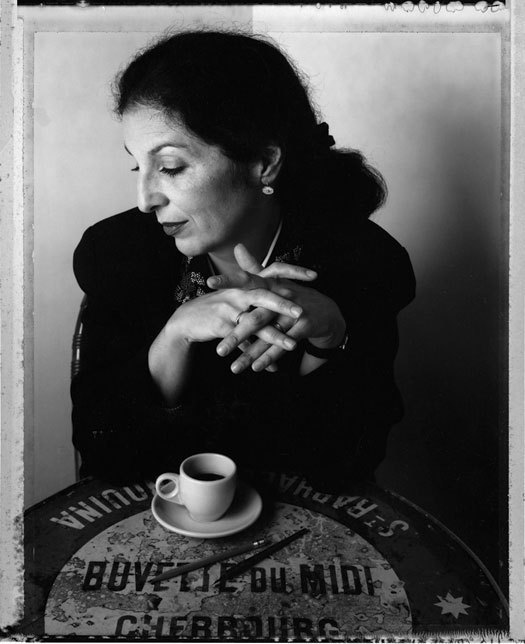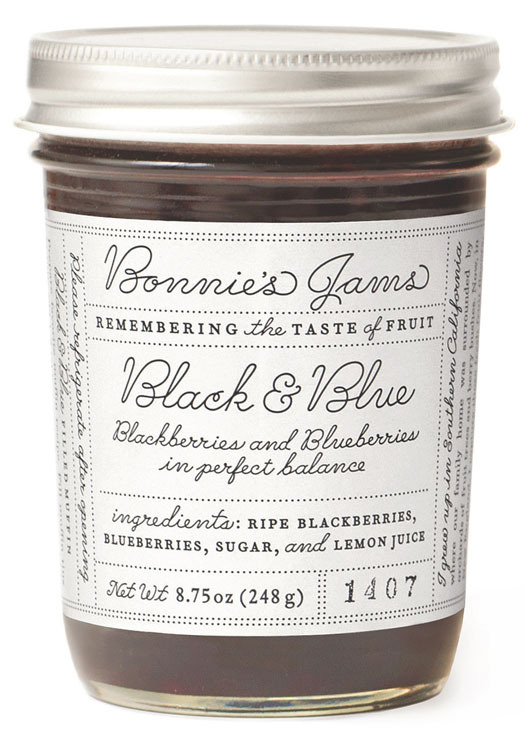++++

Portrait by Henry Leutwyler
Editor’s Note: This is the fifth in a six-part series from Adam Harrison Levy about designers, artists and cooking. To see all the installments, click here.
In 1967, when Louise Fili was sixteen, she saw a billboard that changed her life. It was a sweltering evening in July and she was seated on a bus, having just flown into Milan from New York with her parents. A man and a woman, drawn in the gracefully swooping lines of Art Nouveau illustration, were passionately embracing. Against the darkening night sky she could make out the words Baci and Perugina. The couple, and the lettering, were from a more elegant era: the woman in a flowing dress, the man in an impeccably tailored suit. “The woman was clearly in a swoon, and so was I. In retrospect, I realize that this was the pivotal moment when I fell in love all at once with Italy, type, and food. I was smitten.”
Fili is one of our foremost graphic designers. She specializes in food related logos, restaurant identities and packaging — Sarabeth's preserves and Tate's cookies are iconic examples. She has also designed over two thousand book covers. Her work is stylish and distinctive — whether it's a label for a bottle of wine, a logo for an elegant restaurant or the branding for a line of jams. And it all goes back to that sultry evening in July.

Packaging design by Louise Fili.
Fili was visiting Italy for the first time. Her parents were born there ― her mother was from Calabria and her father from Sicily ― and each had emigrated separately to America when they were young. “I never forgave them for leaving to come to the United States” she says wryly. They settled in New Jersey.
Fili had been primed since childhood for her food-billboard epiphany. When young she would overhear her parent's early morning arguments about what they were going to eat for dinner. “For them, it was the only thing worth arguing about.” These disagreements did not disturb her; they were part of the normal course of her daily life. She couldn't understand why other families weren't as passionate about their food.
During the winter months Fili’s family suffered through the typical American supermarket fare of iceberg lettuce and tasteless tomatoes. But in the spring and summer they reaped the culinary rewards of her father's backyard gardening obsession including arugula and San Marzano tomatoes, unusual delicacies at that time. Her mother was in daily command of the kitchen. She was a competent, practical cook. But her father would take over once a month and turn the kitchen into a chaotic mess. He was unruly and creative.
During that trip in 1967, when the family arrived in the Sicilian village where her father was born (he hadn't been back for forty seven years), they were taken to a cousin's cramped apartment. When they sat down to eat she was handed a glass of almond milk and served a large plate of fish heads. New Jersey must have seemed very far away.
The Arab influence on Sicilian food was astonishing to her. The use of ingredients such as raisins, pine nuts, citrus, saffron, and pistachios gave the sardines and the tuna, the fresh eggplant and zucchini, the lamb and the pasta, a quality that was exotic yet still unmistakably Italian.
The arrival in the village of the American family called for celebration. When they went to eat at the local restaurant the entire village dressed up and lined the streets. During the meal an old man approached their table. “I have a son who lives in Brooklyn,” he said. “Do you know him?”
Even as a teenager Fili had had the unique sensation of being in a place that was foreign yet at the same time strangely familiar. “It is a feeling that I relive every time I travel to Italy ― whether it's a new locale or one that I've visited countless times. It always feels like coming home.”
That sense of returning home to a past that she never experienced informs Fili's work as a graphic designer. Her work evokes an invented Italy ― the lettering looks as if it was printed on old fashioned letterpress and the patterns, designs and colors can evoke Art Deco, Art Nouveau or even late-19th century Italian typography.
But her work is not nostalgic. It's a conscious aesthetic, honed by years of regular travel to Italy, and it is highly specific. Starting in the 1970s Fili has been obsessively documenting the vestiges of classic Italian design on overlooked shop signs and beach billboards. Her packaging, logos and book designs are evocative of these forms. In other words, she excavates the past in order to put it to ultra contemporary usage.
It's not surprising that most of her work is connected with food. In fact, she feels that there are strong continuities between cooking and graphic design. “Both require patience and passion, and they both can be extremely time-consuming, but are always worth the effort.” When asked what advice she would give to young designers Fili says, “Follow your heart. Design what you are passionate about.” The young girl from New Jersey, with her Italian billboard epiphany, would definitely approve.
Pasta al cartoccio — Pasta Baked in Parchment
I cook linguine for a few minutes less than usual, then mix it with a puttanesca sauce and bake individual portions wrapped in parchment paper. (Tracing paper works equally well.)
INGREDIENTS
1/4 cup extra virgin olive oil
1 clove garlic, peeled and left whole
1 large can Italian tomatoes, drained
large pinch of hot red pepper flakes
3 large plum tomatoes
1 medium bunch Italian parsley, chopped
1 cup pitted Kalamata olives
1 tablespoon extra virgin olive oil
1 pound linguine or fettucine
cooking parchment — or tracing paper!
INSTRUCTIONS
1) In a large pan, sauté garlic in oil for 3 minutes. Remove garlic and add the canned tomatoes. Simmer for 20 minutes. Season with salt and pepper, and add the hot red pepper. Pass it through a food mill and return to the pan over medium heat for 10 more minutes. Set aside.
2) Boil water in a large pot and add a teaspoon of Kosher salt. Drop in the fresh tomatoes for about 3 minutes. Remove with a slotted spoon and plunge into a bowl of cold water. Remove skins, remove the seeds and chop the tomatoes.
3) Preheat the oven to 375F. Bring a large pot of water to boil and add a teaspoon of Kosher salt. Add the pasta and cook for a few minutes less than the norm for al dente pasta.
4) Prepare 6 pieces of parchment or tracing paper (about 8.5 x 11 in.) on a counter. In a large bowl, combine the chopped tomatoes, parsley, olives, tomato sauce, 1 tablespoon oil, and salt and pepper to taste. Drain the pasta and add it to the bowl. Mix well. Divide the contents into 6 servings, and place each onto a parchment sheet and wrap tightly. Place all packages snugly into a baking pan and bake for 15 minutes.
5) Place each portion in a pasta bowl and cut open with scissors. Serve immediately. Buon Appetito!
A version of this essay originally ran on Gourmet Live!

